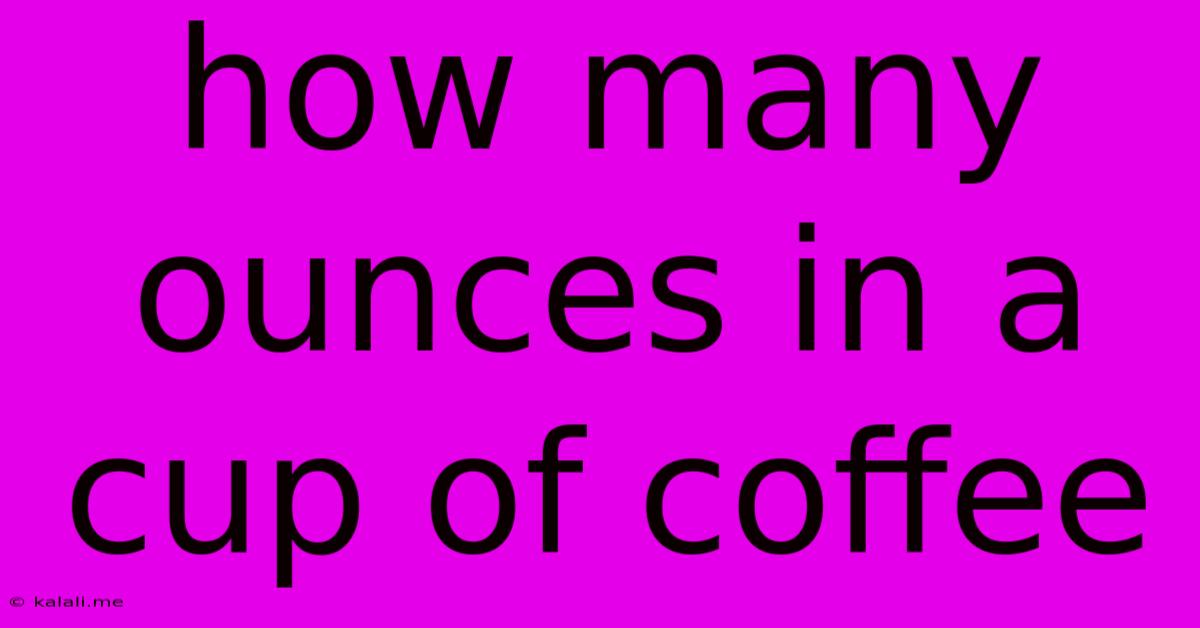How Many Ounces In A Cup Of Coffee
Kalali
May 24, 2025 · 3 min read

Table of Contents
How Many Ounces in a Cup of Coffee? A Comprehensive Guide
Meta Description: Wondering how many ounces are in a cup of coffee? This guide clarifies the common confusion around coffee measurements, exploring standard cup sizes and variations you might encounter.
The simple answer to "how many ounces in a cup of coffee?" is 8 fluid ounces. However, like many things in the culinary world, it’s not always that straightforward. The measurement of a "cup" of coffee can vary depending on several factors, leading to some confusion. This comprehensive guide will explore the different sizes and contexts you might encounter.
Standard vs. Actual Coffee Cup Sizes
The standard measurement for a cup in the US is 8 fluid ounces (fl oz). This is often the basis for coffee recipes and brewing instructions. However, the actual size of a coffee cup you use at home or in a cafe can differ significantly.
-
Restaurant and Café Cups: Many coffee shops serve coffee in cups that are larger than 8 ounces, ranging from 10 to 16 ounces or even more for specialty coffee drinks. These larger servings often don't reflect the actual amount of coffee grounds used – instead, it's the size of the container.
-
Home Brewing: At home, you might use mugs or travel tumblers of varying sizes. These can easily hold more or less than 8 ounces of brewed coffee.
-
Recipe Variations: Coffee recipes, particularly for drip coffee makers, often specify the amount of coffee grounds and water in cups. This measurement is usually based on the standard 8-ounce cup. However, be mindful that the resulting brewed coffee volume might slightly vary due to coffee bean type and grind size.
Understanding Fluid Ounces and Metric Equivalents
It's crucial to understand the difference between fluid ounces and other volume measurements, particularly if you're following recipes from international sources.
-
Fluid Ounces (fl oz): This is a unit of volume used to measure liquids, specifically in the US customary system. 8 fl oz equals one US customary cup.
-
Metric Equivalents: One US cup (8 fl oz) is approximately equal to 237 milliliters (ml). If a recipe calls for a metric measurement, ensure you accurately convert it to ensure consistent results.
Factors Influencing Coffee Volume
Several factors can affect the actual volume of coffee in a cup:
-
Brewing Method: Different brewing methods (drip, French press, pour-over) yield different coffee-to-water ratios and ultimately, different volumes of brewed coffee.
-
Coffee Bean Type and Roast: Different coffee beans absorb varying amounts of water during brewing, slightly impacting the final brewed volume.
-
Grind Size: A coarser grind typically results in a slightly less dense brew compared to a finer grind.
Measuring Your Coffee Accurately
For consistent coffee brewing, accurate measurement is key. Consider these tips:
-
Use a Measuring Cup: Use a liquid measuring cup designed for accurate fluid ounce measurements to ensure consistent results when brewing coffee.
-
Scale Your Coffee: For precision, using a kitchen scale to weigh your coffee grounds and water is the most accurate way to ensure consistent brewing.
-
Understand Your Equipment: Familiarize yourself with the actual capacity of your coffee maker and serving cups to better understand the resulting coffee volume.
In conclusion, while a standard cup of coffee is generally considered to be 8 fluid ounces, the actual amount you receive or brew can vary depending on several factors. Understanding these variations and employing accurate measuring techniques will help you achieve the perfect cup every time.
Latest Posts
Latest Posts
-
One Piece Driveshaft Vs Two Piece
May 24, 2025
-
I See Said The Blind Man Meaning
May 24, 2025
-
How To Join 2x4 End To End
May 24, 2025
-
How To Fill A 2 Inch Gap In Concrete
May 24, 2025
-
Starcraft 2 Make An Arcade Game
May 24, 2025
Related Post
Thank you for visiting our website which covers about How Many Ounces In A Cup Of Coffee . We hope the information provided has been useful to you. Feel free to contact us if you have any questions or need further assistance. See you next time and don't miss to bookmark.